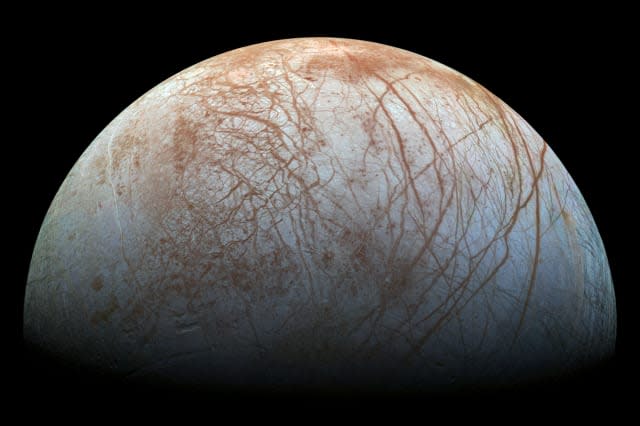Dark material on Jupiter's moon 'may be sea salt'

Sea salt may be responsible for mysterious dark material spotted on Jupiter's moon Europa, scientists believe.
The salt coating long cracks in the moon's icy surface is thought to have welled up from a hidden ocean below.
There is strong evidence that Europa has a global liquid water ocean beneath a layer of ice tens of miles thick, kept from freezing by powerful tidal forces caused by Jupiter's gravity. WORDS: PA.
It could be deep enough to contain more water than all the oceans on Earth combined, and may provide conditions suitable for life.
Now the American space agency Nasa has conducted laboratory experiments that suggest the dark material discovered more than a decade ago may be ordinary salt.
The scientists chilled samples of common salt - sodium chloride - to minus 173C (minus 279F) and bombarded them with electrons to simulate conditions on the moon's highly irradiated surface.
They found that the white salt turned yellowish-brown, matching the colour of the "stripes" identified by Nasa's Galileo spacecraft.
The longer the samples were exposed - a few tens of hours being the equivalent to a century on Europa - the darker the salt became.

Planetary scientist Dr Kevin Hand, from Nasa's Jet Propulsion Laboratory in Pasadena, California, said: "This work tells us the chemical signature of radiation-baked sodium chloride is a compelling match to spacecraft data for Europa's mystery material."
The cracks are analogous to tectonic plates on Earth and may be places where material from below the icy layer erupts to the surface.
The combination of briny water and relative warmth beneath the moon's frigid exterior raises the tantalising possibility of some form of marine life evolving on Europa.
Dr Curt Neibur, Outer Planets Program scientists at Nasa headquarters in Washington DC, who also took part in the study reported in the journal Geophysical Research Letters, said: "We have many questions about Europa, the most important and most difficult to answer being is there life?
"Research like this is important because it focuses on questions we can definitively answer, like whether or not Europa is inhabitable.
"Once we have those answers, we can tackle the bigger question about life in the ocean beneath Europa's ice shell."
Previous research has attributed the discolourations on Europa's surface to compounds containing sulphur and magnesium.

Europa is the fourth-largest of Jupiter's 67 moons and roughly the size of our own moon.
It was discovered by the pioneering Italian astronomer Galileo Galilei in 1610 and is named after a figure from Greek mythology.
The moon is believed to have an iron core surrounded by a thick rocky mantle, a layer of liquid ocean, and an icy surface.
As Europa orbits its giant parent planet, gravitational forces similar to those responsible for the tides on Earth squeeze and stretch its solid interior, generating heat.
Nasa is planning a new mission to Europa in 2025 which will map the moon's surface in more detail than ever before.
This could be followed by a more ambitious project to land on the moon's surface and drill down through the ice.
There is even a suggestion to send a miniature submersible through the borehole and into the ocean.
Related articles:
In pictures: the world from space
Sarah Brightman prepares for launch into Space
New Virgin Galactic plane on the way





